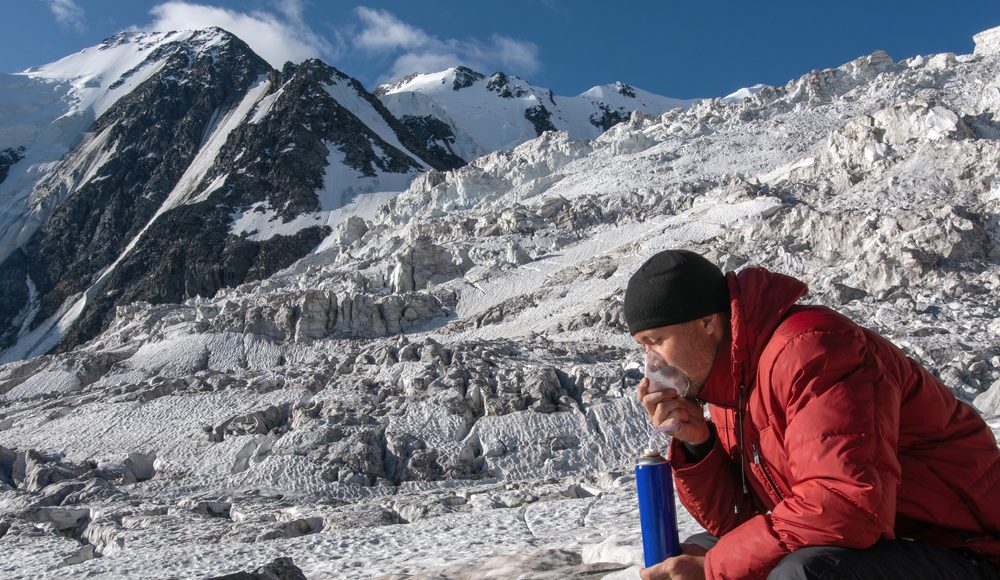Trekking up a mountain to experience the beauty of nature, hunt elusive prey, or escape certain doom becomes a problematic experience the longer you’re climbing the mountain.
For some folks, months of preparation and training are required to undertake such a task, and when they’re up there on the mountain, they can’t believe they’re doing it. Everything seems well until they feel a headache coming on, soon to be followed by nausea.
They trained for months, and they’re already exhausted. How about that?
They feel confused, and they soon start to feel sick, almost like being drunk. What should they do?
They are experiencing acute mountain sickness or AMS, a condition common in people traveling to altitudes above 8,000, with a general incidence rate of about 25% of all travelers. However, for those traveling directly to the Mountain Everest area or visiting the Himalayas, the incidence is somewhere around 50 to 85%.
Now, you’re probably not planning to visit the Himalayas any time soon, but if you want to try your luck at high-altitude hunting to bag a goat and even elk or deer, you should learn a thing or two about AMS. Such a hunting trip can often find you camped at 8,000-10,000 feet or higher, and you need to prepare your travel schedule to acclimatize for a few days.
Understanding the severity of AMS
AMS was commonly called altitude illness by mountain men, and it was the primary term to describe what was happening to city folks when they wandered on the mountain and got sick. AMS occurs when a person’s body doesn’t have enough time to adapt to the lower pressure and oxygen found at a higher altitude.
This “altitude sickness” is, in fact, a group of general symptoms that begin to manifest once a person is climbing or walking to a higher and higher elevation too quickly. The more you advance without realizing what’s happening to you, the worse you will get.
The problem is that mild symptoms are often confused with the onset of a viral illness, and people wrongly assume they caught a bug or something because they feel tired and have a headache. However, it’s the altitude that’s causing your body to react the way it does.
The symptoms of AMS that will sometimes include loss of appetite, dizziness, and sleep problems will most often start within 12 to 24 hours of arriving at your camping place at a high altitude, and they tend to last just a couple of days as the person gets used to the higher elevation.
Most people experiencing mild symptoms such as headaches and fatigue will recover just fine if they stop their trip, slow down, or descent. The descent is the keyword here, and it’s the main course of action if they aren’t getting any better.
Once symptoms intensify to an intermediate state, and the person starts to feel a general weakness and shortness of breath, chances are they won’t feel better even if they took over-the-counter medicine. Their situation can deteriorate further over time. The person will soon start to have difficulty walking, loss of coordination, and a severe headache. They will feel a tightness or congestion in the chest, and vomiting will occur.
Severe altitude sickness comes with an inability to walk, shortness of breath even at rest, confusion, and fluid build-up in the lungs and/or brain (brain and lung edema). Coughing may also be present, and the person will have pale or bluish skin. The situation can worsen to a coma and become deadly. It becomes critical to begin descent immediately and seek medical help.
My experience
My first serious encounter with altitude sickness occurred in 2017 when together with a group of friends, we went to Tanzania and climbed Kilimanjaro. I knew altitude sickness was a risk because I’ve experienced mild symptoms in the past during my hiking trips. We decided to book a guide and pay for the five-day package since it would make it easier to acclimate to the altitude.
We had a briefing with our guide before leaving for the base camp, and everyone in our group took Diamox to fight altitude sickness as soon as we started the climb. Once we reached the base camp, the guide briefed us about the weather and told us what we should expect in the following days, what we will see, and the usual stuff. We had dinner, and we went to bed early to be fresh the next day.
However, as soon as I woke up, I knew something wasn’t right since I was light-headed and nauseous. At first, I didn’t make a great deal out of it since I wasn’t the only one in our group experiencing these symptoms. I told myself I could push on, so I reassured everyone that we could move forward, including our guide.
After heaving breakfast despite the lack of appetite, I started climbing with the group. After an hour or so, I found it more and more challenging to pull myself up. I stopped to rest for a few seconds, and I remember feeling exhausted. It felt like my whole body was heavy, and I couldn’t believe I lost all my strength all of a sudden. I sat down next to a rock as I felt dizzy.
The guide noticed my situation and came back to check up on me. He looked into my eyes with a flashlight and kept asking what my name was. However, I couldn’t come up with my name no matter how hard I tried. Finally, the guide advised me to begin the descent since it’s not worth the risk. I decided he was right, and one of the friends from my group helped me start the descent.
We were at 14,000 feet at that time, and once we reached 12,000 feet, I started feeling better. I suddenly regained all my health, and I could have a conversation with my friend. By the time we reached the camp, I felt alive again, and It all seemed like a thing of the past.
My wife and some of our friends started feeling nauseated as they saw me beginning the descent, but for them, it was more of mental fear and anxiety rather than altitude sickness. They continued pushing on, and the guide regularly did “medical checkups” to see if they could continue the ascend. They all made it to the top.
Even though things didn’t go as planned, I still consider the trip a fantastic experience and a learned lesson. Even more, I cannot overestimate the importance of having some professionals with you when you decide to explore unknown territories.
The guide knew everything there was to know about AMS, calorie intake and nutrition, and hydration. He made the right call advising me to go back to camp, and I’m glad I’ve listened to him.
What you should do to acclimate your body to high altitude
To prevent altitude sickness and acclimate your body to a high altitude without significant issues, here are a few things you can do.
- Being well hydrated and fed is very important, and you should drink 1 gallon of water per day. Also, you should eat even if you don’t feel hungry. Always stay hydrated and avoid alcohol consumption.
- Move at a slow place since you need to give your body time to get used to the thin air. Even if you’re part of a group, everyone should pace themselves since everyone adapts at a different rate.
- Do acclimatization hikes. Climb to a higher altitude during the day and set camp at a lower elevation at night. This is something professional climbers do, and they call it “climb high, sleep low.” It’s a type of altitude training, and it’s known to help them adapt easier to high altitude.
- Always look for common symptoms such as headache, fatigue, lightheadedness, loss of appetite, sleeplessness, and nausea. These are deciding factors to convince a climber to head down.
- Some experienced climbers look for changes in their partners’ behavior, such as walking pace, balance, how they speak, food and water intake, and energy level. They can figure out quickly if someone suffers from AMS, and you need to learn how to spot these signs if you plan to take part in a hiking adventure at a high altitude.
- There’s no point in pushing you forward once you notice you might suffer from AMS as the rate of deterioration could speed up, and beginning to descent may be the only difference between life and death.
- If you get stuck at a high altitude because of weather or an injury, rescue workers will bring oxygen to treat altitude mountain sickness, but you shouldn’t count on it. Begin the descent and slow your pace to avoid injuries and give your body time to adapt to the change in oxygen pressure.
If you live near sea level, understand that your body might be at risk when traveling to a higher altitude destination since your body isn’t used to dealing with a lower pressure of oxygen. You may be at risk even if you are traveling by car or when you are flying.
Concluding
Planning a slow ascend is perhaps the best advice you can get to avoid dealing with altitude sickness, and it’s one of the main things you can control. Traveling to a high-altitude location is about the altitude and how fast you get there.
If you’re not careful, mild symptoms can lead to severe altitude sickness, and your situation can worse to a come and become deadly. Make sure you plan your trip carefully, one step at a time.
>>> GET THE BOOK TO DISCOVER MORE <<<











Daniel | August 28, 2021
|
I know you didn’t list everything concerning severe condition but is highly sensitive to light one of them? How about severe pounding headaches as though brain is about to burst out or sound sensitivity. I had all those symptoms, even moving a little added to my discomfort.
Just curious, I’m a survivor!
J | September 14, 2021
|
I heard Viagra helps
K | October 25, 2021
|
I have severe sensitivity to light . It happens to me alot going from Denver to Scoqualmie pass in washington… very nauseated, coughing , pounding headache, lack of breath… i have tadalifil, gonna try some now.